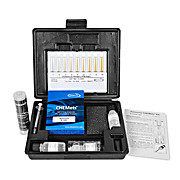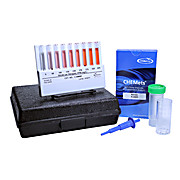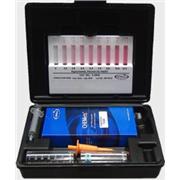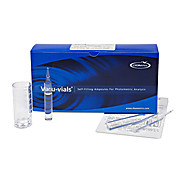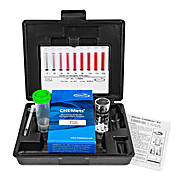CHEMetrics Portable Water Quality Test Kits
-
Ammonia HBA Test Kit
CHEMetricsLow-level ammonia nitrogen may be naturally present in water as a result of the biological decay of plant and animal matter. Higher concentrations in surface waters can indicate contamination from waste treatment facilities, raw sewage, industrial effluents (particularly from petroleum refineries),…
-
Sulfide CHEMets® Kits
CHEMetricsSulfides are naturally present in ground waters as a result of leaching from sulfur-containing mineral deposits. Surface waters do not usually contain high sulfide concentrations. Sulfides result from the decomposition of organic matter, from bacterial sulfate reduction under anaerobic conditions…
-
Formaldehyde CHEMets Kit
CHEMetricsFormaldehyde, a toxic substance, is used in the following applications: metal plating baths, textile treatments, biological specimen preservatives, and disinfectants of medical equipment. Commercial formaldehyde gas is readily soluble in water. The Purpald Method Reference:…
-
Phosphate Vacu-vials® Kits
CHEMetricsPhosphorus occurs naturally in rock formations in the earth's crust, usually as phosphate. High phosphate concentrations in surface waters may indicate fertilizer runoff, domestic waste discharge, or the presence of industrial effluents or detergents. Although phosphates from these sources are…
-
Low-level ammonia nitrogen may be naturally present in water as a result of the biological decay of plant and animal matter. Higher concentrations in surface waters can indicate contamination from waste treatment facilities, raw sewage, industrial effluents (particularly from petroleum refineries),…
-
Sulfide Vacu-vials® Kits
CHEMetricsSulfides are naturally present in ground waters as a result of leaching from sulfur-containing mineral deposits. Surface waters do not usually contain high sulfide concentrations. Sulfides result from the decomposition of organic matter, from bacterial sulfate reduction under anaerobic conditions…
-
Nitrate CHEMets Kit, Range: 0-675 ppm
CHEMetricsNitrate is the most completely oxidized form of nitrogen. It is formed during the final stages of biological decomposition, either in wastewater treatment facilities or in natural water supplies. Low-level nitrate concentrations may be present in natural waters. However, a Maximum Contaminant Level…
-
Iron is present in nature in the form of its oxides, or in combination with silicon or sulfur. The soluble iron content of surface waters rarely exceeds 1 mg/L, while ground waters often contain higher concentrations. The National Secondary Drinking Water Standard for iron is 0.3 mg/L, as iron…
-
Molybdate CHEMets Kit, Range: 2-24 ppm
CHEMetricsMolybdate is used throughout the industrial water treatment and power generation industries as a corrosion inhibitor in both open- and closed-loop cooling water systems. In solution, molybdate anions complex with oxidized iron to form a protective film of molybdate and ferric-oxide. Molybdate is…
-
Ammonia HBA Test Kit
CHEMetricsLow-level ammonia nitrogen may be naturally present in water as a result of the biological decay of plant and animal matter. Higher concentrations in surface waters can indicate contamination from waste treatment facilities, raw sewage, industrial effluents (particularly from petroleum refineries),…
-
Hydrogen peroxide is a strong oxidizing agent with a variety of uses. Applications include the treating of industrial effluents and domestic waste and serving as a disinfectant in aseptic packaging. For the food and beverage industry, CHEMetrics Hydrogen Peroxide CHEMets® and…
-
Because of its strong oxidizing properties, chlorine is an excellent biocide used to treat potable waters, municipal wastes, and swimming pools. When used to treat potable water, chlorine helps alleviate the adverse effects of iron, manganese, ammonia, and sulfide. The Maximum Residual Disinfectant…
-
Cyanide (Free) Vacu-vials Kit
CHEMetricsCyanide is used in many chemical and refining processes. It is found in effluent from electroplating and metal cleaning operations, coke ovens, steel manufacturing facilities, and gas scrubbers. Although cyanide can be safely removed by alkaline chlorination, its acute toxicity to aquatic life…
-
Method Dissolved carbon dioxide (CO2) is naturally present as a result of animal respiration, the decay of organic matter, and the decomposition of certain minerals. It is the major source of acidity in unpolluted water samples. Surface waters typically contain less than 10 ppm…
-
 Chlorine (Free & Total) CHEMets® Kits
CHEMetrics
Chlorine (Free & Total) CHEMets® Kits
CHEMetricsBecause of its strong oxidizing properties, chlorine is an excellent biocide used to treat potable waters, municipal wastes, and swimming pools. When used to treat potable water, chlorine helps alleviate the adverse effects of iron, manganese, ammonia, and sulfide. The Maximum Residual Disinfectant…
-
Nitrite Vacu-vials Kit
CHEMetricsNitrite, an intermediate in the nitrogen cycle, is formed during the decomposition of organic matter but readily oxidizes to form nitrate. These processes occur in wastewater treatment plants, water distribution systems, and natural waters. Nitrites are useful as corrosion inhibitors,…
-
Silica Vacu-vials® Kits
CHEMetricsSilica (SiO2) is the oxide of silicon, the second most abundant element in the earth's crust. Silica is present as silicates in most natural waters. Typical concentrations lie between 1 and 30 mg/L. Higher concentrations may exist in brackish waters and brines. The silica content of…
-
 Phenols CHEMets® Kits
CHEMetrics
Phenols CHEMets® Kits
CHEMetricsPhenol (hydroxybenzene) is the simplest of a group of similar organic chemicals, which includes cresols, xylenols, and catechols. Phenol itself is a common ingredient of disinfectants. In drinking water, low-level phenolic concentrations impart a foul taste and odor, especially upon chlorination.…
-
Nitrate CHEMets Kit, Range: 0-225 ppm
CHEMetricsNitrate is the most completely oxidized form of nitrogen. It is formed during the final stages of biological decomposition, either in wastewater treatment facilities or in natural water supplies. Low-level nitrate concentrations may be present in natural waters. However, a Maximum Contaminant Level…
-
Ammonia Vacu-vials Kit, Range: 0-7.00 ppm
CHEMetricsLow-level ammonia nitrogen may be naturally present in water as a result of the biological decay of plant and animal matter. Higher concentrations in surface waters can indicate contamination from waste treatment facilities, raw sewage, industrial effluents (particularly from petroleum refineries),…
-
Sulfite (free) Titrets® Titration Cells
CHEMetricsSulfite is not usually present in surface waters. If sulfite is discharged in effluents or from domestic wastewaters, it readily oxidizes to form sulfate. Sodium sulfite is the most common form of sulfite and is an excellent reducing agent with applications as an oxygen scavenger. Sulfite…
-
Chloride Titrets® Test Kits
CHEMetricsChloride is the most common inorganic anion found in water and wastewater. The Maximum Secondary Contaminant Level for drinking water for chloride is 250 mg/L. Natural sources of salt are the ocean and various salt deposits above and below ground. Chloride is very corrosive to most metals in…
-
Iron in Brine CHEMets Kit
CHEMetricsIron is present in nature in the form of its oxides, or in combination with silicon or sulfur. The soluble iron content of surface waters rarely exceeds 1 mg/L, while ground waters often contain higher concentrations. The National Secondary Drinking Water Standard for iron is 0.3 mg/L, as iron…
-
Ozone CHEMets Kit
CHEMetricsOzone is a strong oxidizing agent and is used as an alternative to chlorine as a biocide in the disinfection of drinking water. Ozone is used to remove odor, decolorize, and to control algae and other aquatic growths. Ozone is also used in various disinfectant and sterilization processes in…
-
Hardness is a measure of the mineral content of water. Calcium and magnesium are the most common minerals that contribute to hardness. Hard water causes scaling in boilers and other industrial equipment, and diminishes the effectiveness of soaps and detergents. The EDTA Method (Total) …
-
Sulfide VACUettes® Kits
CHEMetricsSulfides are naturally present in ground waters as a result of leaching from sulfur-containing mineral deposits. Surface waters do not usually contain high sulfide concentrations. Sulfides result from the decomposition of organic matter, from bacterial sulfate reduction under anaerobic conditions…
-
Phenols Vacu-vials® Kits
CHEMetricsPhenol (hydroxybenzene) is the simplest of a group of similar organic chemicals, which includes cresols, xylenols, and catechols. Phenol itself is a common ingredient of disinfectants. In drinking water, low-level phenolic concentrations impart a foul taste and odor, especially upon chlorination.…
-
Copper (Soluble) Vacu-vials Kit
CHEMetricsCopper is naturally present in the earth’s crust and in seawater. Copper-containing fungicides are used to control biological growth in water supplies. The Maximum Contaminant Level Goal for copper is 1.3 mg/L in drinking water. The measurement of copper is an important means of monitoring…
-
Phenols VACUettes® Kits
CHEMetricsPhenol (hydroxybenzene) is the simplest of a group of similar organic chemicals, which includes cresols, xylenols, and catechols. Phenol itself is a common ingredient of disinfectants. In drinking water, low-level phenolic concentrations impart a foul taste and odor, especially upon chlorination.…
-
DEHA Titrets Kit
CHEMetricsDissolved oxygen in boiler system water causes corrosion and pitting of metal surfaces, which can lead to boiler inefficiency, equipment failure, and system downtime. DEHA (N,N-Diethylhydroxylamine) is added to boiler system water as an oxygen scavenger to keep the dissolved oxygen levels as low as…
-
Carbohydrazide CHEMets Kit
CHEMetricsCarbohydrazide is added to boiler system water as an oxygen scavenger to control corrosion. It is a safer alternative to hydrazine, which is toxic. Carbohydrazide reacts with oxygen at low temperatures and pressures. The products of the reaction are volatile and do not contribute dissolved solids…
-
Nitrite CHEMets Kit, Range: 0-2.5 ppm
CHEMetricsNitrite, an intermediate in the nitrogen cycle, is formed during the decomposition of organic matter but readily oxidizes to form nitrate. These processes occur in wastewater treatment plants, water distribution systems, and natural waters. Nitrites are useful as corrosion inhibitors,…







